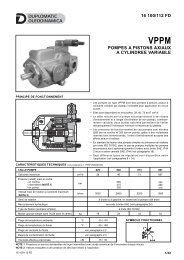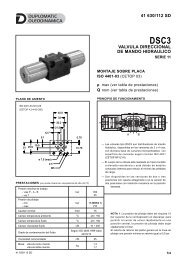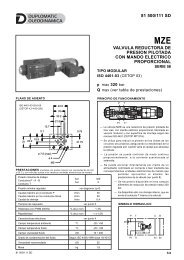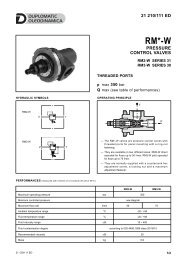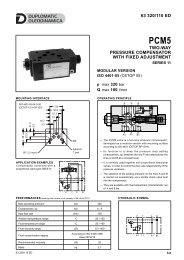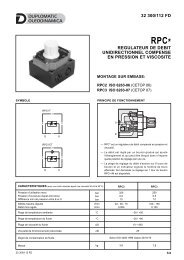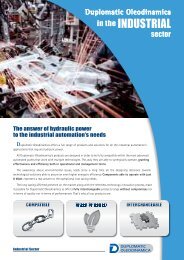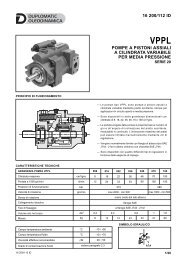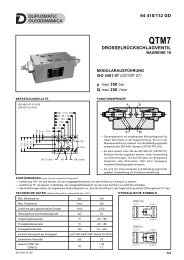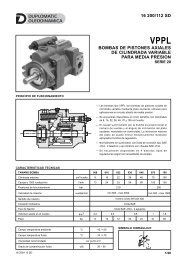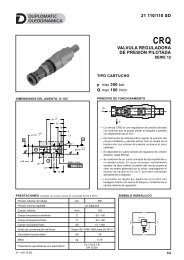DSP7 - Duplomatic
DSP7 - Duplomatic
DSP7 - Duplomatic
Create successful ePaper yourself
Turn your PDF publications into a flip-book with our unique Google optimized e-Paper software.
<strong>DSP7</strong><br />
10 - ELECTRICAL FEATURES<br />
10.1 Solenoids<br />
These are essentially made up of two parts: tube and coil. The<br />
tube is threaded into the valve body and includes the armature that<br />
moves immersed in oil, without wear. The inner part, in contact with<br />
the oil in the return line, ensures heat dissipation.<br />
The coil is fastened to the tube by a threaded ring, and can be<br />
rotated 360°, to suit the available space.<br />
NOTE 1: In order to further reduce the emissions, use of type H<br />
connectors is recommended. These prevent voltage peaks on<br />
opening of the coil supply electrical circuit (see CAT. 49 000).<br />
NOTE 2: The IP65 protection degree is guaranteed only with the<br />
connector correctly connected and installed.<br />
VOLTAGE SUPPLY FLUCTUATION<br />
MAX SWITCH ON FREQUENCY<br />
± 10% Vnom<br />
10.000 ins/hr<br />
DUTY CYCLE 100%<br />
ELECTROMAGNETIC COMPATIBILITY<br />
(EMC) (NOTE 1)<br />
LOW VOLTAGE<br />
CLASS OF PROTECTION:<br />
Atmospheric agents (CEI EN 60529)<br />
Coil insulation (VDE 0580)<br />
Impregnation: CC valve<br />
CA valve<br />
In compliance with<br />
2004/108/CE<br />
In compliance with<br />
2006/95/CE<br />
IP 65 (NOTE 2)<br />
class H<br />
class F<br />
class H<br />
10.2 Current and absorbed power for DC<br />
solenoid valve<br />
The table shows current and power consumption values<br />
relevant to the different coil types for DC.<br />
The rectified current supply takes place by fitting the<br />
valve (with the exception of D12 coil) with an alternating<br />
current source (50 or 60 Hz), rectified by means of a<br />
bridge built-in to the “D” type connectors (see cat.<br />
49 000), by considering a reduction of the operating<br />
limits by 5 ÷ 10% approx.<br />
Coils for direct current (values ± 5%)<br />
Suffix Nominal Resistance Current Power Coil<br />
voltage at 20°C consumpt. consumpt. code<br />
[V] [ohm] [A] [W]<br />
D12 12 4,4 2,72 32,7 1903080<br />
D24 24 18,6 1,29 31 1903081<br />
D48 48 78,6 0,61 29,5 1903083<br />
D110 110 423 0,26 28,2 1903084<br />
D220 220 1692 0,13 28,2 1903085<br />
10.3 Current and absorbed power for AC solenoid valve<br />
The table shows current and power consumption values at inrush and at holding, relevant to the different coil types for AC current.<br />
Coils for alternating current (values ± 5%)<br />
Suffix Nominal Frequency Resistance Current Current Power Power Coil<br />
voltage at 20°C consumption consumption consumption consumption code<br />
at inrush at holding at inrush at holding<br />
[V] [Hz] [ohm] [A] [A] [VA] [VA]<br />
A24 24 50 1,46 8 2 192 48 1902830<br />
A48 48 50 5,84 4,4 1,1 204 51 1902831<br />
A110<br />
110V-50Hz<br />
120V-60Hz<br />
1,84<br />
1,56<br />
0,46<br />
0,39<br />
192<br />
188<br />
48<br />
47<br />
32<br />
1902832<br />
A230<br />
230V-50Hz<br />
50/60<br />
0,76 0,19 176 44<br />
240V-60Hz<br />
140<br />
0,6 0,15 144 36<br />
1902833<br />
F110 110<br />
26 1,6 0,4 176 44 1902834<br />
60<br />
F220 220 106 0,8 0,2 180 45 1902835<br />
41 420/112 ED 8/12




